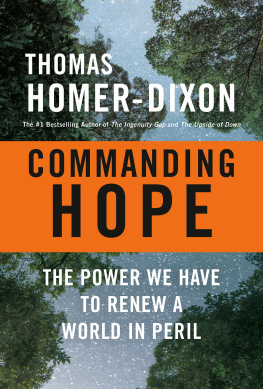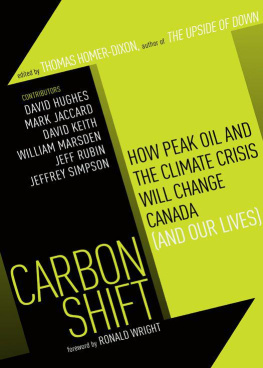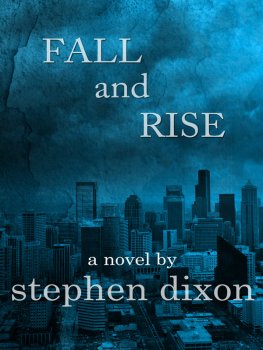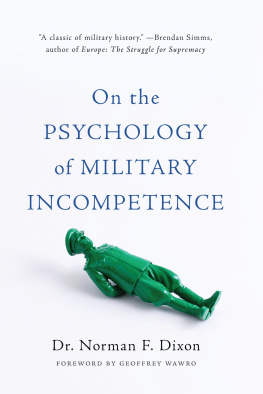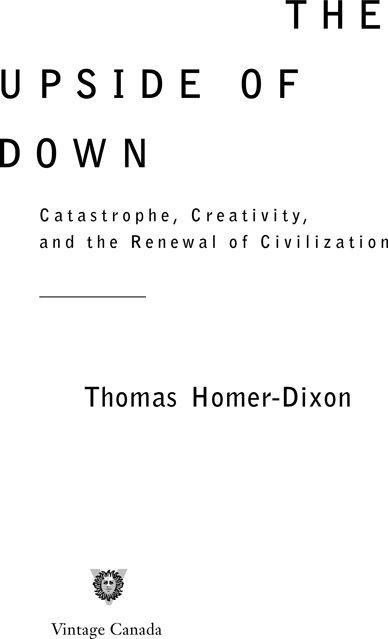Anyone who doubts the seriousness of the human predicament should read Thomas Homer-Dixons brilliant The Upside of Down. Anyone who understands the seriousness should also read it.
Paul R. Ehrlich, President, Center for Conservation Biology at Stanford University
This book is an impressive achievement thoughtful and thoughtprovoking. For those who want a clear and accessible overview of this catastrophist debate, and one with a Canadian flavour this is a useful place to start.
An extraordinarily important book. If you read only one book this year about the end of civilization, let this be it.
There isnt any book out there quite like it. [Thomas Homer- Dixon] is fast emerging as an especially eloquent voice among the English-speaking worlds most insightful thinkers on the great chal- lenges of our time. Well-written, engaging, and lively, from the beginning to the end.
Thomas Homer-Dixon is the giant-killer of overwhelming issues.
For over a decade, Thomas Homer-Dixon has provided that rare thing: a bridge between leading-edge research and the lay reader. Now, addressing the greatest problems of our time, he points us towards a path forward.
Robert D. Kaplan, Senior Fellow, Foreign Policy Research Institute
CONTENTS

Hollow
Societies
prologue
FIRESTORM

San Francisco, Thursday, April 19, 1906
T HE WIND had shifted. Now the inferno turned its attention westward. Block by block, it savaged some of the citys finest houses. As the mayor, chief of police, and members of the municipal council retreated from building to building before the flames, they decided the city would make one last stand.
The final line of defense, they announced, would be Van Ness Avenuea broad residential boulevard bisecting San Francisco from north to south. The street lay directly in the fires path: if they could use it as a firebreak, they might be able to halt the advance. But if this last effort failed, what remained of the city would surely be lost.
Early the previous day, an enormous earthquake had shattered the citys core, snapping cast-iron water mains like twigs, toppling thousands of chimneys, and upending coal-burning stoves and boilers. Electrical utility poles fell over, bringing down live wires in showers of sparks. Gas lines ruptured. Kerosene and oil poured out of burst fuel tanks. In seconds, sparks and fuel combined, and dozens of fires exploded across the city. Then, energized by the wood in the citys buildings, small fires coalesced into mighty firestorms. Even when firefighters could maneuver around the piles of earthquake debris in the streets, they found no water in the hydrants.
By noon on the 19th, the fire had destroyed almost ten square kilometers of the city east of Van Ness Avenue. The financial district, Market Street, and the district south of Market were smoking ruins, Chinatown was ablaze, and the docks, ferry terminal, and Telegraph Hill were under siege. The U.S. army had tried to deprive the fire of easily combustible material by blowing up hundreds of undamaged buildings in front of the flames. But so far their efforts had been futile, and supplies of dynamite were almost gone.
Orders went out to concentrate all soldiers, police, workers, and fire engines for the climactic fight along a sixteen-block section of Van Ness. They would raze the houses along the east side of the boulevard. So the last pounds of dynamite were brought on wagons from the Presidio and Alcatraz, placed in the buildings basements, and connected to fuses. Police and volunteers rushed from house to house to evacuate residents. And because there wasnt enough dynamite, the army wheeled field cannon into position along the west side of Van Ness. The guns muzzles pointed across the street.
The fire crested Nob Hill a few blocks to the east, enveloped the brand-new Fairmont Hotel, and now surged down California, Sacramento, and Washington Streets toward Van Ness. A broad wall of flames and smoke closed in on the defenders.
At 4 p.m., the cannon opened fire on the elegant mansions lining the east side of the street. The sight was one of stupendous and appalling havoc, wrote a correspondent for The New York Times, as the cannons were trained on the palaces and the shot tore into the walls and toppled the buildings in ruins. Simultaneously fuses were lit, and as the dynamite exploded, the dwellings of millionaires were lifted into the air by the power of the blast and dropped to the earth a mass of dust and debris.
For hours, above the roar of the approaching flames, the air shook with the steady concussion of exploding artillery shells and dynamite. When the fire reached Van Ness, it seemed it would breach the defensive line. The fire spread across the broad thoroughfare, wrote the Times correspondent, and the entire western addition, which contains the homes of San Franciscos wealthier class, seemed doomed. But when the smoke cleared the next morning, the defenders found to their joy that their strategy had been largely successful. The flames had jumped the street in only a few places.
By then, though, it was obvious that much of the city had been obliterated. Hundreds of thousands of people had no shelter or food, and authorities feared famine and epidemic. Looking across San Franciscos smoldering hulk that day, no one could have imagined that such appalling
Rome, Tuesday, May 13, 2003
The late-afternoon Italian sun is low in the sky, but still hot. In the shade of a tree, Im enjoying a blessed moment of tranquillity. Im perched atop the stubby base of a pillar among the ruins of the Forum in Romethe center of political, religious, and public life through much of Ancient Romes history.
I look northwest toward the Arch of Septimius Severus and the Temple of Saturn. In front of me is a broad expanse of wild grass that shimmers green and gold. Here and there stand pitted and cracked imperial columns, crumpled brick arches, and bits and pieces of travertine steps broken remnants of Romes triumph and power.
A breeze ruffles the grass.
Im visiting Rome on a journey to better understand the complex problems we faceproblems like energy shortages, climate change, disease, and economic crisis. And while it may be a moment of tranquillity for me, in mid-May 2003 much of the world is in turmoil. In the past weeks, a string of suicide bombings ripped through Israel. Terrorists attacked Western targets in Riyadh and Casablanca. Indonesia launched a war against rebels in the province of Aceh. The United Nations warned of a new genocide in northeastern Congo. A virulent form of pneumonia, SARS, caused near panic from Beijing to my home city of Toronto. And the United States and its allies achieved a lopsided military triumph over Saddam Husseins regime in Iraq. The victory seemed to confirm the United States as an imperial power, certainly the greatest since the Roman empire, and perhapsin terms of the gulf between America and its nearest competitors in military and economic strengththe greatest of all time.


